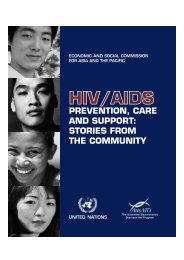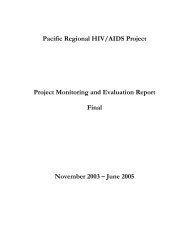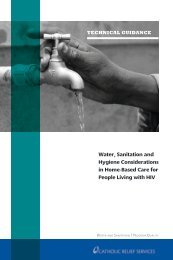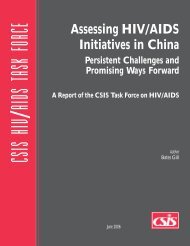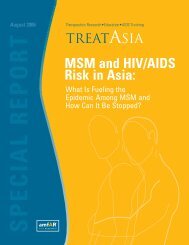The State of Business and HIV/AIDS (2006) - Booz Allen Hamilton
The State of Business and HIV/AIDS (2006) - Booz Allen Hamilton
The State of Business and HIV/AIDS (2006) - Booz Allen Hamilton
You also want an ePaper? Increase the reach of your titles
YUMPU automatically turns print PDFs into web optimized ePapers that Google loves.
44 3 Baseline: Current <strong>State</strong> <strong>of</strong> <strong>Business</strong> <strong>and</strong> <strong>AIDS</strong><br />
3.7.2 Monitoring, Evaluation <strong>and</strong> Reporting<br />
Monitoring, evaluation <strong>and</strong> reporting allows<br />
organizations to demonstrate the effectiveness <strong>of</strong><br />
any given program. Thirty-two percent <strong>of</strong> companies<br />
report that they use a recognized measurement<br />
methodology for monitoring <strong>and</strong> evaluation. Twentynine<br />
percent ensure reporting <strong>of</strong> <strong>HIV</strong> performance<br />
measurements in annual reports. Monitoring <strong>and</strong><br />
evaluation is an area that companies described<br />
as “difficult” in interviews. <strong>The</strong>y described the<br />
difficulties <strong>of</strong> isolating their own workforce from the<br />
general population when monitoring <strong>HIV</strong>/<strong>AIDS</strong> <strong>and</strong><br />
the challenges posed by the time required to track<br />
prevalence <strong>and</strong> new incidents <strong>and</strong> measure behavior<br />
change (figure 27). More common is documentation<br />
<strong>of</strong> programs (63 percent) <strong>and</strong> use <strong>of</strong> internal process<br />
to discuss, rather than forward measures.<br />
Those companies interviewed identified various<br />
methods for monitoring <strong>and</strong> evaluation, for example:<br />
targets. Unless all employees agree to voluntary<br />
testing a company cannot really measure progress<br />
in preventing new infections <strong>and</strong> keeping people<br />
well. Two <strong>of</strong> the member companies interviewed<br />
are taking their programs further with targets for<br />
preventing new <strong>HIV</strong> infections, reducing the number<br />
<strong>of</strong> people becoming sick or dying from <strong>HIV</strong>/<strong>AIDS</strong>,<br />
<strong>and</strong> babies being born <strong>HIV</strong>-positive. One <strong>of</strong> the<br />
companies reported that these targets are both<br />
achievable <strong>and</strong> measurable, but 100 percent <strong>of</strong><br />
employees must first volunteer for testing.<br />
Now established, this baseline sets an important<br />
reference point from which to measure future<br />
progress, consider the level <strong>of</strong> effort <strong>and</strong> impact<br />
made to date, but perhaps most vitally gives<br />
business a new resource with which to consider<br />
its own efforts <strong>and</strong> how to move forward <strong>and</strong><br />
further raise the bar.<br />
• Consumer goods companies are able to link the<br />
success <strong>of</strong> their programs to sales.<br />
• Those investing in others’ programs ensure<br />
projects have set targets <strong>and</strong> indicators <strong>of</strong><br />
progress established up front.<br />
• Multinational corporations interviewed <strong>of</strong>ten<br />
monitor at a regional level (several also have<br />
structured global programs or roadmaps against<br />
which their regional operations can be tracked).<br />
Several <strong>of</strong> the leading companies are shifting<br />
from process-based reporting to measuring actual<br />
outcomes. <strong>The</strong> general KPI (key performance<br />
indicators) used is the proportion <strong>of</strong> the workforce<br />
being tested each year, <strong>and</strong> some set annual testing




